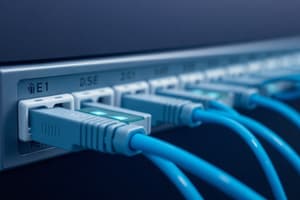Podcast
Questions and Answers
What is the purpose of a demarcation point in a WAN?
What is the purpose of a demarcation point in a WAN?
The demarcation point is where the service provider's network ends and the customer's network begins.
Define the term 'last mile' in the context of WAN connections.
Define the term 'last mile' in the context of WAN connections.
The 'last mile' refers to the final leg of the telecommunications networks that deliver internet services to end-users.
What differentiates a public WAN from a private WAN?
What differentiates a public WAN from a private WAN?
A public WAN is open to all users and typically uses shared infrastructure, whereas a private WAN is dedicated to a specific organization and uses private connections.
Explain the role of a CSU/DSU in a WAN.
Explain the role of a CSU/DSU in a WAN.
What is Dense Wavelength Division Multiplexing (DWDM) and its primary function?
What is Dense Wavelength Division Multiplexing (DWDM) and its primary function?
What distinguishes DSL from shared mediums in terms of user connectivity?
What distinguishes DSL from shared mediums in terms of user connectivity?
How does PPP serve users in a DSL connection?
How does PPP serve users in a DSL connection?
What are the two deployment methods for PPPoE?
What are the two deployment methods for PPPoE?
What is the role of the Cable Modem Termination System (CMTS) in cable technology?
What is the role of the Cable Modem Termination System (CMTS) in cable technology?
What standard is used to add high-bandwidth data to cable systems?
What standard is used to add high-bandwidth data to cable systems?
How do local subscribers experience bandwidth in cable technology?
How do local subscribers experience bandwidth in cable technology?
What is the function of the optical node in cable technology?
What is the function of the optical node in cable technology?
What advantage does DSL have over cable technology in terms of performance?
What advantage does DSL have over cable technology in terms of performance?
What is the primary purpose of using site-to-site and remote access VPNs in an organization?
What is the primary purpose of using site-to-site and remote access VPNs in an organization?
Name two recognized authorities that define modern WAN standards.
Name two recognized authorities that define modern WAN standards.
What are Layer 1 optical fiber protocol standards used for?
What are Layer 1 optical fiber protocol standards used for?
What distinguishes circuit-switched WAN technologies from packet-switched technologies?
What distinguishes circuit-switched WAN technologies from packet-switched technologies?
Which Layer 2 protocol is known for interconnecting enterprise LANs?
Which Layer 2 protocol is known for interconnecting enterprise LANs?
What is a major disadvantage of a hub-and-spoke topology?
What is a major disadvantage of a hub-and-spoke topology?
Explain the main difference between serial and parallel communication.
Explain the main difference between serial and parallel communication.
What type of signals does ISDN enable the PSTN local loop to carry?
What type of signals does ISDN enable the PSTN local loop to carry?
How does the dual-homed topology enhance network performance?
How does the dual-homed topology enhance network performance?
What does ATM technology utilize for transferring data?
What does ATM technology utilize for transferring data?
What makes the fully meshed topology the most fault-tolerant?
What makes the fully meshed topology the most fault-tolerant?
In a hub-and-spoke topology, how can spoke routers communicate with each other?
In a hub-and-spoke topology, how can spoke routers communicate with each other?
What is the role of Layer 2 protocols in WAN technology?
What is the role of Layer 2 protocols in WAN technology?
Which two technologies are considered the most common types of circuit-switched WAN?
Which two technologies are considered the most common types of circuit-switched WAN?
Why can dual-homed topologies be more expensive than single-homed topologies?
Why can dual-homed topologies be more expensive than single-homed topologies?
What is a characteristic of a partially meshed topology?
What is a characteristic of a partially meshed topology?
What configuration challenges may arise when implementing dual-homed topologies?
What configuration challenges may arise when implementing dual-homed topologies?
What does a fully meshed topology inherently improve for a network?
What does a fully meshed topology inherently improve for a network?
Can spoke routers in a hub-and-spoke topology directly communicate with each other?
Can spoke routers in a hub-and-spoke topology directly communicate with each other?
What are the requirements for implementing a fully meshed topology?
What are the requirements for implementing a fully meshed topology?
What is the primary purpose of a Wide Area Network (WAN)?
What is the primary purpose of a Wide Area Network (WAN)?
What differentiates a private WAN from a public WAN?
What differentiates a private WAN from a public WAN?
List the five logical topologies used in WAN implementations.
List the five logical topologies used in WAN implementations.
How does a dual-carrier connection benefit a WAN?
How does a dual-carrier connection benefit a WAN?
What influences the choice of broadband access options in WAN design?
What influences the choice of broadband access options in WAN design?
Why is it important to investigate broadband distribution when configuring WANs?
Why is it important to investigate broadband distribution when configuring WANs?
What is the relationship between WANs and ISPs?
What is the relationship between WANs and ISPs?
Can you describe a hub-and-spoke topology in a WAN?
Can you describe a hub-and-spoke topology in a WAN?
What factors must be considered when researching broadband access options for a business?
What factors must be considered when researching broadband access options for a business?
In what scenario would a fully meshed topology be most beneficial?
In what scenario would a fully meshed topology be most beneficial?
Flashcards are hidden until you start studying
Study Notes
DSL and PPP
- DSL provides dedicated direct connections to the DSLAM for each user, ensuring performance is unaffected by the number of users.
- PPP (Point-to-Point Protocol) is used as the Layer 2 protocol for broadband DSL, allowing subscriber authentication and public IPv4 address assignment.
- PPP supports link-quality management features, crucial for maintaining connection stability.
- PPPoE (PPP over Ethernet) has two deployment methods: via a host with PPoE client software or through the router acting as the PPoE client obtaining configuration from the provider.
Cable Technology
- Cable technology offers high-speed, always-on internet connectivity via coaxial cable from service providers.
- DOCSIS (Data over Cable Service Interface Specification) is the standard facilitating high-bandwidth data transmission over cable systems.
- Optical nodes convert RF signals to light pulses via fiber-optic cables, enabling long-distance signal travel to Cable Modem Termination Systems (CMTS).
- All local subscribers share bandwidth; high user numbers can lead to decreased performance due to limited availability.
WAN Topologies
- Hub-and-Spoke Topology: A single hub router shares an interface with all spoke circuits; inter-spoke communication depends on the hub, creating a potential single point of failure.
- Dual-homed Topology: Enhances redundancy and load balancing but is costlier and more complex to implement due to additional hardware requirements.
- Fully Meshed Topology: Each site is interconnected through multiple virtual circuits, providing high fault tolerance.
- Partially Meshed Topology: Connects several sites without full interconnectivity.
WAN Connectivity and Protocols
- WANs extend connectivity beyond local area networks (LANs), often using public or private connections established by ISPs.
- Common WAN logical topologies include point-to-point, hub-and-spoke, dual-homed, fully meshed, and partially meshed.
- Modern WAN standards are governed by authorities such as TIA/EIA, ISO, and IEEE, with key Layer 1 protocols (SDH, SONET, DWDM) addressing optical fiber communications.
- Layer 2 protocols, which encapsulate data into frames, include broadband, wireless, Ethernet WAN, MPLS, PPP, and HDLC.
Communication Types
- Serial communication transmits bits sequentially through one channel, while parallel communication sends several bits simultaneously over multiple wires.
- Common circuit-switched WAN technologies include PSTN and ISDN, whereas packet-switched technologies encompass Ethernet WAN and MPLS.
- Frame Relay is a simple Layer 2 NBMA (Non-Broadcast Multi-Access) technology for linking enterprise LANs, while ATM facilitates voice, video, and data transfers using a cell-based approach.
New Terms and Commands
- Definitions include various network technology terms such as public and private WAN, DSL modem, cable modem, CSU/DSU, SDH, SONET, and ATM.
- Key components also include CPE (customer premises equipment), T-carrier, E-carrier, frame relay, and Virtual Private LAN service (VPLS).
Studying That Suits You
Use AI to generate personalized quizzes and flashcards to suit your learning preferences.




